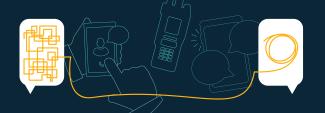Public safety’s best friend
After working with the U.S. Navy Marine Mammal Program during graduate school, I knew I wanted to work with service animals in my career. I served as Administrative Sergeant for the San Diego County Sheriff’s Department Search and Rescue K9 Unit, and stayed with the search and rescue team for twelve years. One of my proudest moments was working with my first search dog, Foley, to locate a twelve-year-old boy and reunite him with his mother.
I’m a big believer that all dogs need a job, and K9 units continue to proliferate across public safety doing more and different types of jobs every day. We rely on dogs for many tasks that no human or technology can do, or that a dog can do much more efficiently. For example, teams searching a warehouse by hand for narcotics or a suspect could take hours or even days to find their target, but a well-trained dog can often cut that search time down to minutes.
The use cases for K9s are remarkably broad. Law enforcement, as an example, uses dogs to search for contraband, track down people, and protect their handlers. Fire departments have arson detection dogs trained to locate accelerants. The medical world uses dogs to predict seizures and diabetic shock, find diseases like cancer, and provide a calming therapy avenue for patients undergoing all sorts of medical care. Search and rescue teams focus on finding the lost subject or, in tragic circumstances, helping to bring closure to a family by locating deceased persons. Finally, state, local, and federal agencies use bomb and agricultural detection dogs every day to secure ports of entry.
Public safety broadband supports K9 units and their handlers
There isn’t a device out there that replaces a K9, but there are many technologies designed to keep them safe and increase their effectiveness. Many of these technologies require a reliable, secure broadband connection, like FirstNet, to function properly.
Heat monitors
Like any of us, dogs are vulnerable to heat exhaustion. Unfortunately, the needs of the job often require canines to be kept in vehicles while their handlers are away. The results can be fatal if a dog is left too long or if air conditioning systems fail. Now, police vehicles can be equipped with heat monitors that alert both handler and central dispatch that temperatures are getting too high for the dog’s safety. Some systems can kick on fans or air conditioning systems, but it is still important for someone to check on the dog right away. These types of sensors can be connected to an officer’s smartphone over broadband so that the officer can be alerted quickly and reliably. One day, they may be incorporated into vehicle-to-everything (V2X) communications, which allow the vehicle to transmit pertinent information over LTE.
Activity Trackers
K9s work hard. And they don’t always know when to stop working. I’ve had the unfortunate experience of seeing a dog medically evacuated due to overexertion. The latest technologies offer the chance to equip our dogs with activity monitors that can track their heart rate and respiratory rate, among other vitals. Even step trackers help us keep an eye on a dog’s well-being. With a reliable broadband connection in place, we can deliver a stream of health information to a handler’s smartphone and reduce the risk of harm to their canine partner.
Situational awareness for handlers
More dogs are being rigged up with camera and GPS tracking equipment. With a broadband network like FirstNet, first responders can download that data over LTE and use it to increase their situational awareness. As a search and rescue volunteer, I can attest to how important this data is. Dog teams are often asked to cover up to 160 acres at a time, and with the dogs coursing in various directions during the search, knowing exactly where they’ve been and what territory they have really covered when out of the handler’s sight is essential. With GPS data, handlers are able to double check their progress against a map to ensure that, between the dog and search team, they had covered their portion of the grid, and command staff are able to accurately coordinate assignments.
Innovating for cities
As hikers get access to better technology, the number of wilderness rescues has started to decrease. Meanwhile, urban rescues are on the rise as teams are tasked with finding lost children, Alzheimer’s patients, and others. Urban rescue can be a challenge as we spread out among buildings and still need to keep in contact. FirstNet’s priority and preemption improve the reliability of mobile broadband for public safety, making it possible for them to communicate in congested scenarios or use smartphone mapping systems to avoid getting lost in the “urban jungle.” Reliable broadband data and voice communications can also help Urban Search and Rescue teams as they search for victims following events such as building collapses, tornadoes, or floods.
That others may live
Search and rescue teams live by the credo “That Others May Live,” a sentiment shared and embodied by first responders across the country. To this day, I am incredibly passionate about the need for highly trained and highly equipped search and rescue teams nationwide, both in wilderness and urban environments. I’m also passionate about the capabilities that trained K9 units bring to public safety operations and the responsibility placed on dog handlers nationwide to protect their partners. My K9 partners and I were proud to serve our community, and I will continue to serve my fellow handlers via my role at the First Responder Network Authority, helping to provide the network and product technologies that will continue to support their life-saving work.




















